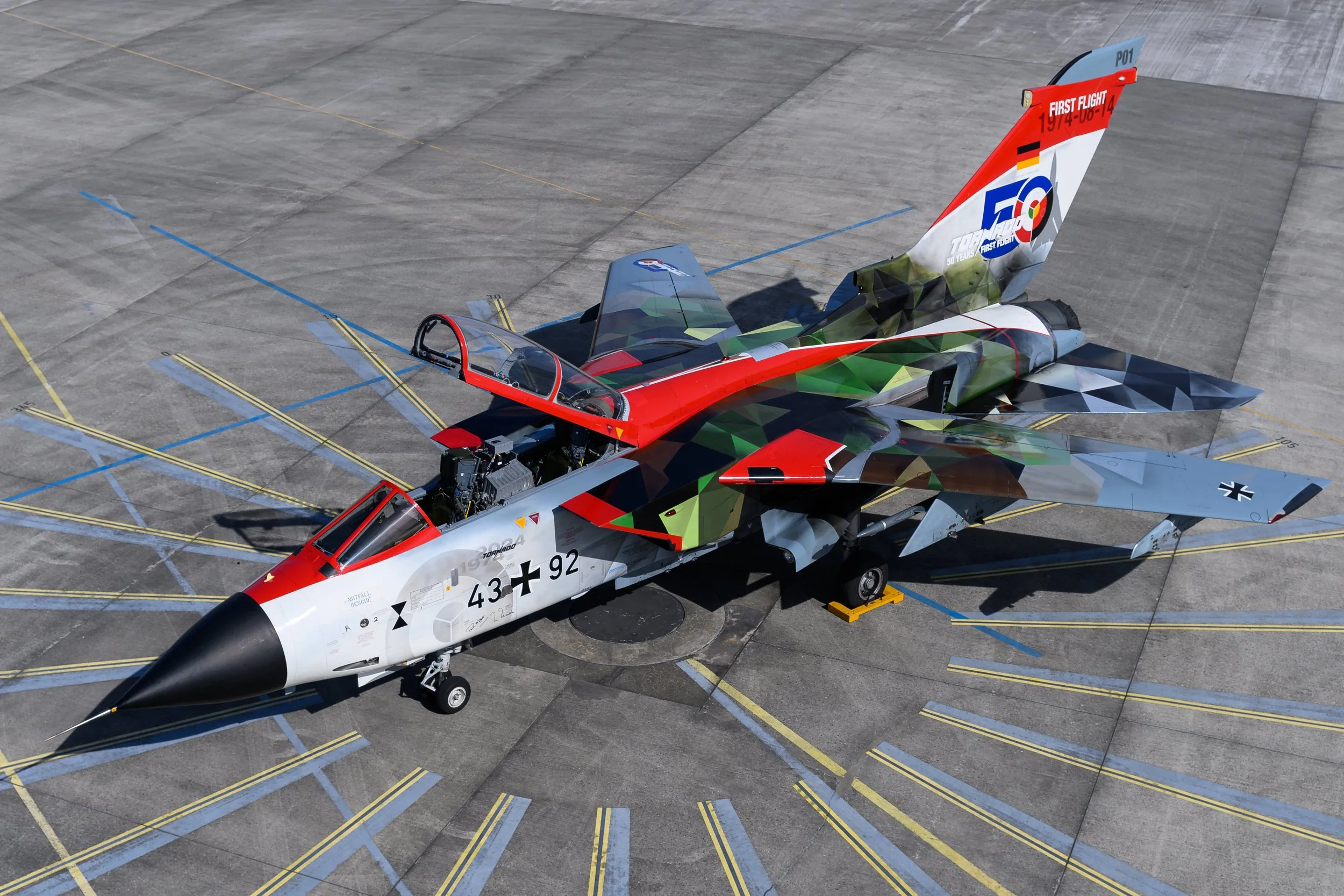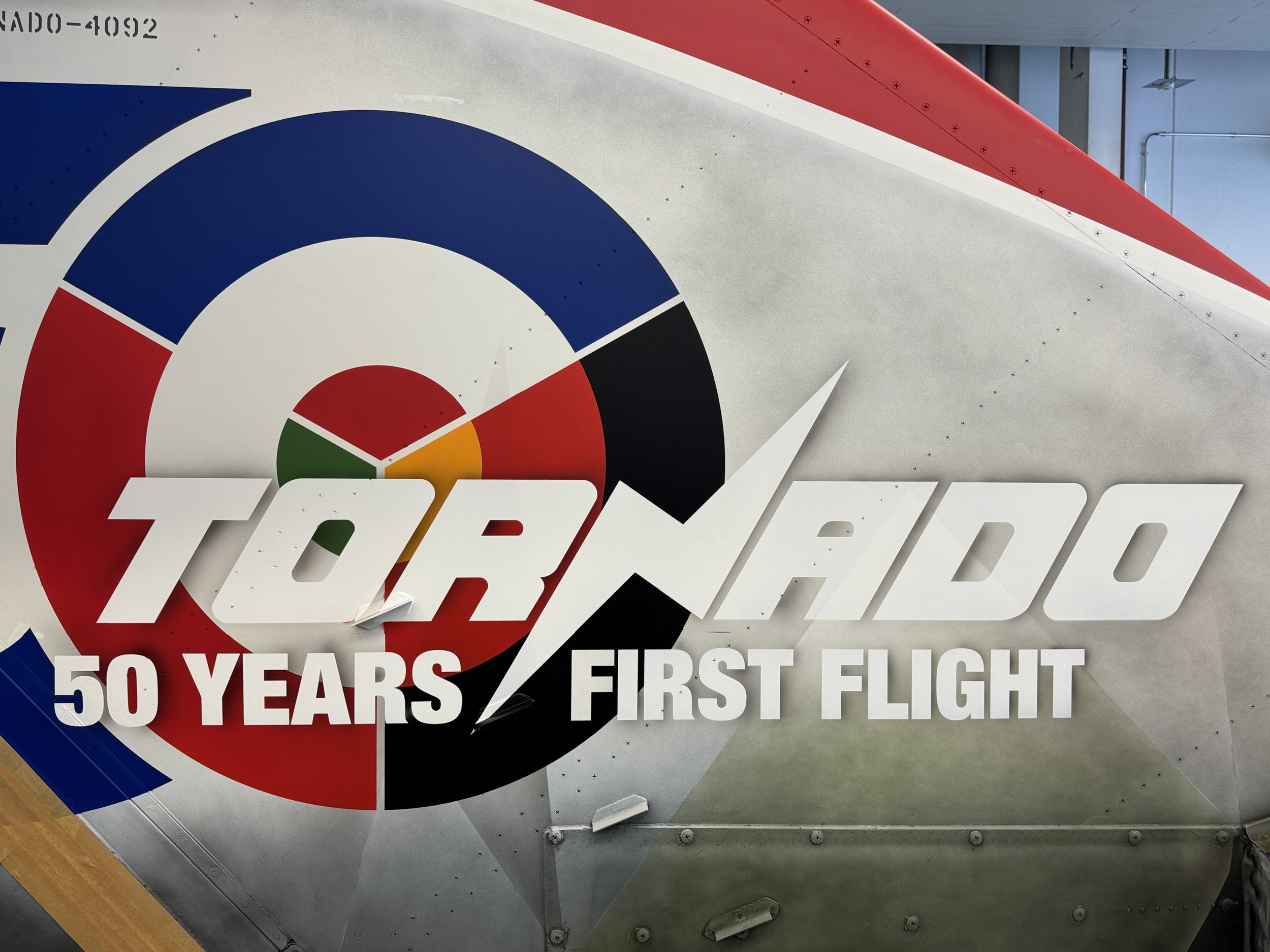The German Air Force is celebrating the 50th anniversary of the Tornado with a special livery.
Airbus Defence has recently unveiled a special paint scheme for a German Air Force Tornado IDS, commemorating the 50th anniversary of the Tornado aircraft's first flight.
The German Air Force's Panavia Tornado IDS, belonging to the Taktisches Luftwaffengeschwader 33 (Tactical Air Force Wing 33), has received a special livery to mark the 50th anniversary of the Tornado aircraft's first flight. This unique design is a tribute to the Tornado's impressive achievements and significant role in aviation history. The paint scheme features eye-catching graphics and colors, which make it visually appealing and a fitting tribute to the aircraft's legacy.
The Tornado is a multi-role combat aircraft that has been in service with the German Air Force since 1980. It comes equipped with two engines and a variable-sweep wing. The special livery of the aircraft showcases a unique design that prominently displays the number "50" on the tail fin along with the Panavia consortium roundel of Germany, Italy, and the United Kingdom.
This customized design pays homage to the pilots and ground crews who have been operating and maintaining the aircraft for the past five decades. It also celebrates the Tornado's long and successful service to the German Air Force.
Tornado IDS in the new colour scheme (Andreas Zeitler, Airbus Copyright)
Tornado in the German Air Force
The German Air Force has a formidable fleet of Tornado aircraft that have played a crucial role in various combat missions. The fleet consists of a total of 247 units, which include IDS variants and other models. To further supplement this fleet, the German Navy transferred their own fleet of 112 Tornado IDS aircraft to the Air Force between 1994 and 2005. This move significantly boosted the Air Force's existing fleet, making it capable of performing a wide range of missions.
The Tornado aircraft have been extensively used in the German Air Force's combat missions in Kosovo and Afghanistan, where they have proven to be highly effective. To maintain their combat readiness, the fleet has been constantly upgraded with the latest technologies and equipment.
The Tornado aircraft has been in service in Germany for over three decades and has played a crucial role in the country's air force. Out of the 357 Tornado aircraft that were delivered, around 80 are still in operational service today. These aircraft are distributed across Germany's two remaining Tornado wings: Taktisches Luftwaffengeschwader 33 (TLG33) located at Büchel air base, near Cochem, and TLG51 ‘Immelmann’ at Schleswig air base, near Jagel.
Both units operate IDS/IDS(T) aircraft, which are capable of performing a wide range of missions including reconnaissance, ground attack, and air-to-air combat. The IDS(T) variant is equipped with additional communication equipment and is used for training purposes.
The ECR (Electronic Combat Reconnaissance) variant of the Tornado aircraft is solely employed by TLG51. These aircraft are designed for specialized missions such as electronic warfare and suppression of enemy air defenses.
The Tornado aircraft, which was introduced in the late 1970s, has undergone several upgrades over the years to ensure that it remains a relevant aircraft in modern warfare. Recent upgrades include the integration of a new radar system by the German Air Force, which has significantly enhanced the aircraft's targeting capabilities. Despite being an ageing aircraft, the Tornado will continue to play a critical role in Germany's air force until it is eventually replaced by newer models such as the Eurofighter Typhoon and the Lockheed Martin F-35 Lightning II.
Despite budget cuts, the German Air Force's Tornado fleet remains a potent combat aircraft capable of performing multiple missions. The Tornado's versatility is its strength, allowing it to be utilized in a range of roles, such as a ground attack, reconnaissance, and air defence. Its ability to deliver nuclear weapons as a NATO Nuclear Bomber has been an important part of the Tornado's mission and it has played a vital role in ensuring the country's national security.
However, with the advancement in technology and the changing nature of warfare, the German government announced in 2021 that the Tornado's nuclear weapon delivery role would be replaced by an order for 35 F-35A Lightning IIs. This decision reflects the government's commitment to modernizing its military capabilities and adapting to changing threats. The F-35A Lightning II is a fifth-generation aircraft that comes with advanced technologies and capabilities that will keep the German Air Force at the forefront of modern warfare.
Overall, the Tornado has been a reliable and versatile aircraft for the German Air Force, serving them well for many years. Nonetheless, the introduction of the F-35A Lightning II is expected to bring new capabilities and advanced technologies to the German Air Force, which will help maintain its military superiority in the future. The replacement of the Tornado with the F-35A Lightning II represents a significant step towards modernizing the German Air Force and equipping it with the latest technology to meet the challenges of the future.
Panavia Tornado
The Panavia Tornado affectionately called the Mighty Fin, was an aircraft that originated from the Multi-Role Combat Aircraft (MRCA) program. It was a joint venture between the UK, Italy, and Germany, with the aim of developing a specialist low-level strike aircraft. Eventually, the program produced 990 Tornados for Saudi Arabia and the partner nations.
The Tornado was produced in three main variants, each with a unique set of capabilities. The IDS variant was the primary strike variant, equipped with a wide range of weapons and advanced avionics systems that allowed it to carry out a broad spectrum of missions. The ECR variant was an advanced anti-radar variant designed to suppress enemy air defences. The ADV variant, on the other hand, was an interceptor variant fitted with more powerful engines, a lengthened fuselage to accommodate extra fuel, and the Foxhunter air-to-air radar.
The Tornado gained notoriety during the first Gulf War for its ability to fly at ultra-low levels, attacking Iraqi airfields with devastating effect. The aircraft's unique capabilities made it the ideal choice for such missions, and it was able to carry out its tasks with exceptional efficiency.
After a long and distinguished career, the Royal Air Force (RAF) retired its last Tornados in 2019. The aircraft had served the UK and its partners for over four decades, and their contribution to the defence of the nation and its allies cannot be overstated.









